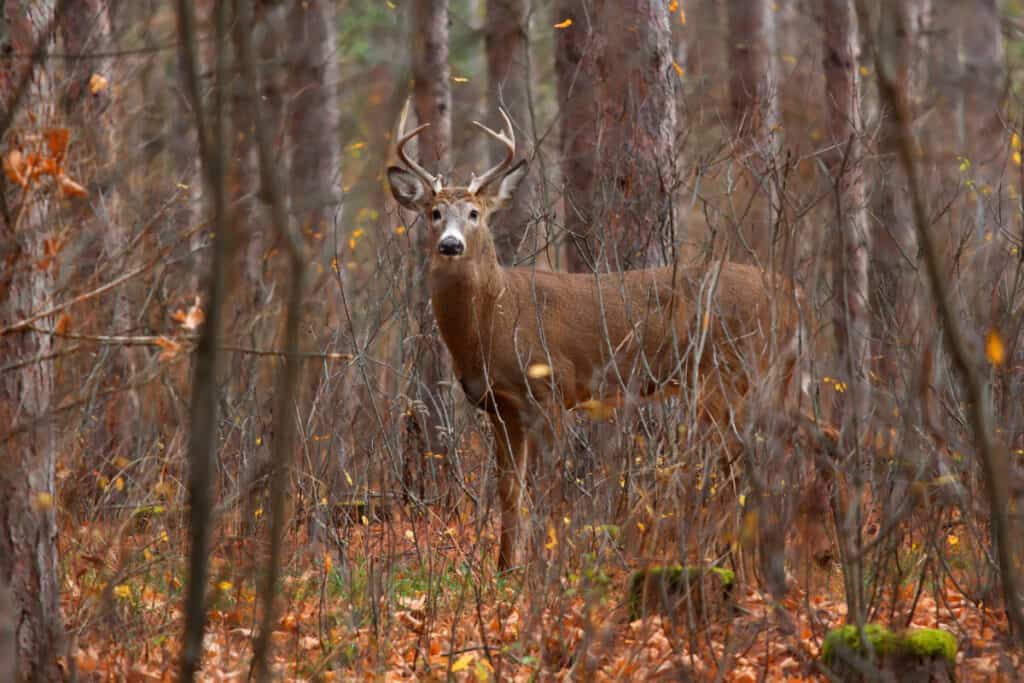How Long It Takes for Gut-Shot Animals to Die

The chances of a hunter going through life without making a gut-shot are very slim, but just how long can it take for an animal to die from being gut-shot?
Depending on the type of firearm used and the animal being hunted, it could take over 24 hours for the animal to die. Normally, it is a distinguishable hit as the animal will hunch its back and trot slowly away. The majority of gunshots to wildlife are fatal.
The common experience of a rushed shot followed by a short blood trail ending at a bed then not being able to find significant blood leaves hunters with emotions and doubts. Let’s walk through the possible causes of death and ways to improve your chances of recovering an animal that has been gut-shot.
How Long to Wait?
There are some obvious variables to consider when determining how long it may take for a gut-shot animal to expire.
An animal shot in the paunch will generally die of infection when bacteria are introduced to the bloodstream via the wound. The infection and blood loss will increase body temperature bringing on dehydration which often drives these wounded animals toward a water source.
The size of the animal, along with the size of the caliber or broadhead used will directly correlate with time till death. Larger animals will take longer for blood loss or terminal levels of infection to set up in the body. A smaller caliber firearm or broad head with less circumference will inflict less trauma causing the expiration time to be extended.
For deer-sized game, the accepted rule is to wait 12 hours before tracking a wounded animal. Twelve hours can feel like an eternity if you are waiting around, so I recommend you take that time to do something productive and enjoyable. There are also situations where waiting 12 hours may be the wrong decision. If there is bad weather on the radar, predators in the area, or a risk of the meat spoiling due to hot conditions, you should consider reducing the wait time to fit the situation.

The Hard Facts and Statistics
There are some clear assumptions we can make about wounded animals and their recovery rate, but does the data support them?
In 1983 a survey was performed by the Michigan Department of Natural Resources of 600 hunters who had gone-a-field in Shiawassee National Wildlife Refuge. Of the deer hit with archery tackle, only 43% were recovered. The successful hunters had all harvested with a bow before and took quartering shots at close range. Of the deer hit with a shotgun slug, 81% were recovered. The discriminant analysis showed that there was a higher success rate of those who had not harvested with a shotgun prior, took shots at animals not running, and also hunted with a bow.
Another study completed in 1997 showed a 50% recovery rate of deer shot with traditional archery tackle. The deer in the sample all had radio collars, and of the 50% not recovered 14% died of their wounds. The 36% that were wounded but not fatally all suffered from flesh wounds or shots in the extremities.
Gut-shot or Not?
I can say from experience that there is a difference between a gut shot and a liver shot. Sometimes when an animal is quartering hard toward you the angle at which the bullet passes through the body will miss the heart and lungs, but catch the liver and gut.
In this situation, the animal will likely behave similarly to a gut shot and hunch its back and trot slowly, but the difference is the rate of blood loss. It is not likely you will find a significant amount of blood, but if you recover the animal you will find it bled internally. It has been my experience that animals shot in this manner die in less than an hour, but if bumped from their first bed they can be difficult to track.
Can the Odds of Recovery Be Improved?
Yes! You can improve your odds of recovering your harvest by following these rules for the field.
- Practice Your Shot
- Follow Up Shots
- Use a Blood Tracking Dog
Practice Makes Almost Perfect
It might sound like common sense, but knowing the range at which you can make an accurate shot is one of the easiest variables to control in the situation. Getting to the range a few times before season might be the difference between meat in the freezer and an empty truck bed.
As a good rule of thumb, reducing the range at which you can perform on the bench by 25% will compensate for inaccurate range estimation. Taking an extra second before executing the shot allows you to check your holds, breathing, and concentrate on a smooth trigger pull. It is easy to jerk the trigger when the trophy of a lifetime is in front of you.
Follow Up Shots
In my personal experience, a follow-up shot is added insurance.
I am not promoting taking the high risk or running shots, but if you know the animal is wounded, it is your duty to bring it down as quickly as possible. Always know what is beyond your shot, and never take a shot at an animal that is on a ridge top or crest. Going back to rule 1, while you are at the range try dual-target drills where you take the initial shot then follow it up quickly with a second shot at a different range.
Get comfortable reloading and finding your mark so that at the moment you can focus on picking a safe shot, trigger pull, and holds.

Man’s best friend, is a trackers biggest asset.
Get On the Scent
In some states, blood tracking dogs are legal to use in the pursuit of wounded animals. Reach out to your local tracker for help and you might be surprised by the results you get. As in any situation, be aware of your state’s trespass laws, and it is always a good idea to let neighbors know what’s going on.
